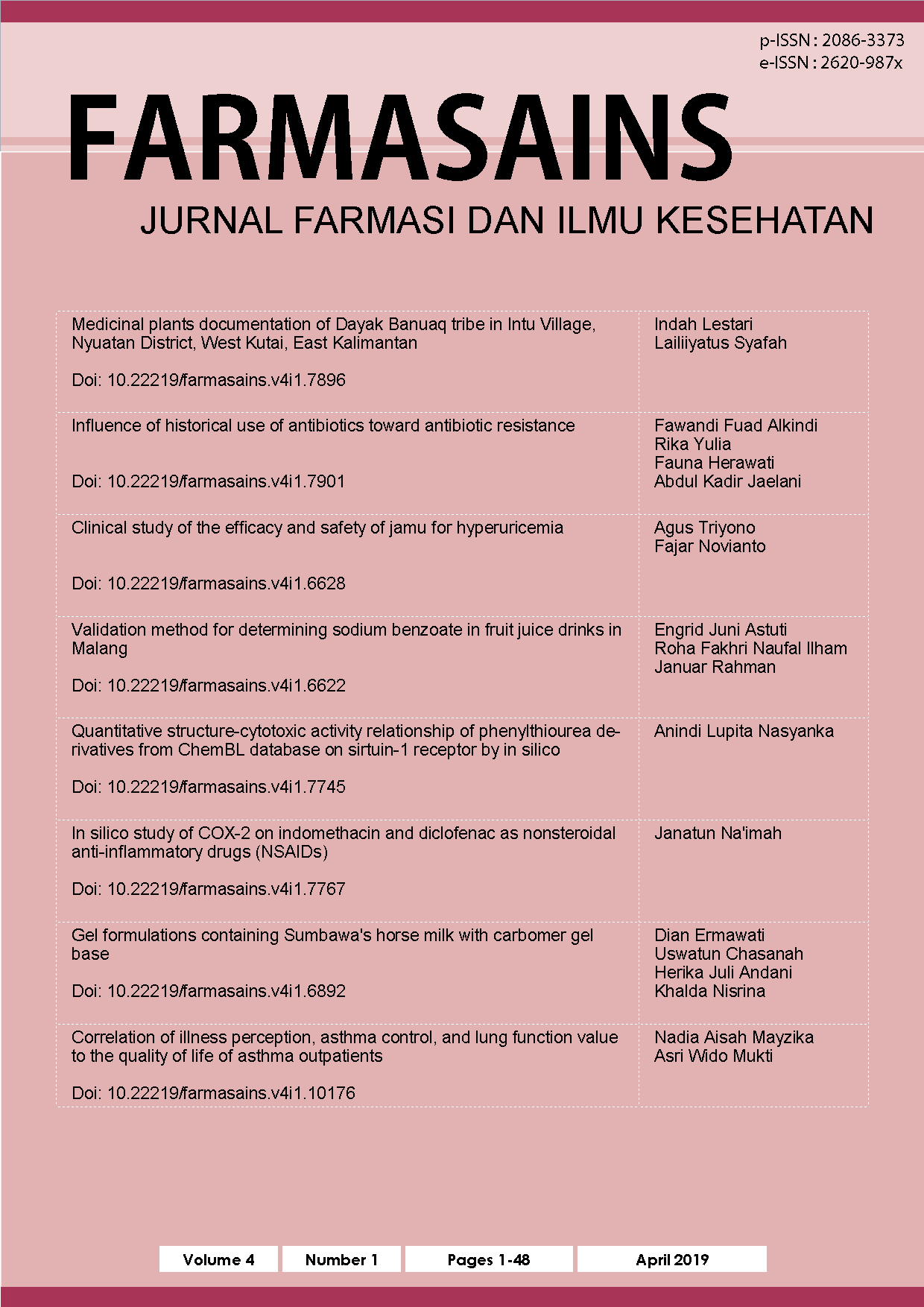Quantitative structure-cytotoxic activity relationship of phenylthiourea derivatives from ChemBL database on sirtuin-1 receptor by in silico
DOI:
https://doi.org/10.22219/farmasains.v4i1.7745Keywords:
QSAR, In silico, Phenylthiourea, Sirtuin-1Abstract
Rational drug design becomes a necessity amid the development of drugs that are inefficient and time-consuming. Hansch's QSAR helps reduce these shortcomings supported by the role of biocomputation. Some of the roles of biocomputation that can be used include in silico testing and the availability of databases for new drug-receptor and ligand candidates. This study aims to determine the QSAR through the search for the best equations analyzed by ANOVA statistics between cytotoxic activity in silico (Log 1/c) anticancer compounds derived from phenylthiourea stored in the ChemBL database with lipophilic parameters (ALPP and AlogP) , electronic (ACDpKa), and its sterics (PMW). The best equation is obtained Log 1/c = -46,194 - 0,152 PMW- 3,769 ALogP - 1,336 ACDpKa with a value of N = 28; F = 20,866; r = 0,850; P = 0,000; SE = 5.82160. In the future, this equation can be used to find other new phenylthiourea derivatives that have better cytotoxic activity.
Downloads
References
Blundell, T. L., Sibanda, B. L., Montalva, R. V., Brewerton, S., Chelliah, V., Worth, C. L., ... & Burke, D. (2006). Structural biology and bioinformatics in drug design: opportunities and challenges for target identification and lead discovery. Philosophical Transactional Royal Society Biological, 361, 413-423.
Chan, S. L., & Labute, P. (2010). Training a scoring function for the alignment of small molecules. Journal of Chemistry Informatics Modelling, 50(9), 1724–1735.
Cancer Index. (2012). GlobalCan. Retrieved February 5, 2019, from: http://www.cancerindex.org/Indonesia.
Hardjono, S. (2012). Modifikasi struktur 1-(benzoiloksi)urea dan hubungan Kuantitatif struktur-aktivitas sitotoksiknya. Doctoral’s Dissertation. University of Airlangga, Surabaya, Indonesia.
Li, L.., Wang, l., Li, L., Wang, Z., Ho, Y., McDonald, T., ... & Bhatia, R. (2012). Activation of p53 by SIRT1 Inhibition Enhances Elimination of CML Leukemia Stem Cells in Combination with Imatinib. Cancer Cell, 21(2), 266–281.
Mandal, S., Moudgil, M., & Mandal, S. K., (2009). Rational drug design. European Journal of Pharmacology, 625(1-3), 90–100.
McCarthy A. R., Pirrie, L., Hollick, J. J., Ronseaux, S., Campbell, J., Higgins, M., ... & Westwood, N. J. (2012). Synthesis and biological characterisation of sirtuin inhibitors based on the tenovins. Bioorganic & Medicinal Chemistry, 20(5) 1779–1793.
Martin, Y. C. (2010). Quantitative drug design: a critical introduction. CRC Press.
Plutín, A. M., Mocelo, R., Alvarez, A., Ramos, R., Castellano, E. E., Cominetti, M. R., ... & Batista, A. A. (2014). On the cytotoxic activity of Pd (II) complexes of N, N-disubstituted-N′-acyl thioureas. Journal of inorganic biochemistry, 134, 76-82.
World Health Organization, (2012). Cancer. Retrieved Juli 28, 2018, from http://www.who.int/mediacentre/factsheets/fs297/en/.
Downloads
Published
How to Cite
Issue
Section
License
Copyright (c) 2019 Anindi Lupita Nasyanka

This work is licensed under a Creative Commons Attribution 4.0 International License.
Authors who publish with this journal agree to the following terms:
a. Authors retain copyright and grant the journal right of first publication with the work simultaneously licensed under a Creative Commons Attribution License that allows others to share the work with an acknowledgement of the work's authorship and initial publication in this journal.
b. Authors are able to enter into separate, additional contractual arrangements for the non-exclusive distribution of the journal's published version of the work (e.g., post it to an institutional repository or publish it in a book), with an acknowledgement of its initial publication in this journal.
c. Authors are permitted and encouraged to post their work online (e.g., in institutional repositories or on their website) prior to and during the submission process, as it can lead to productive exchanges, as well as earlier and greater citation of published work (See The Effect of Open Access).













